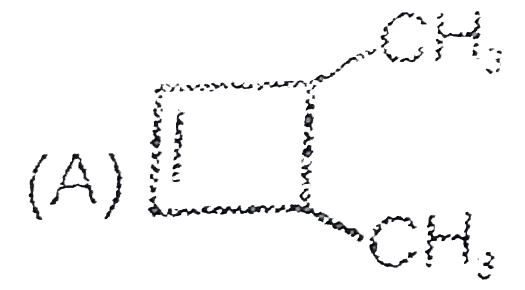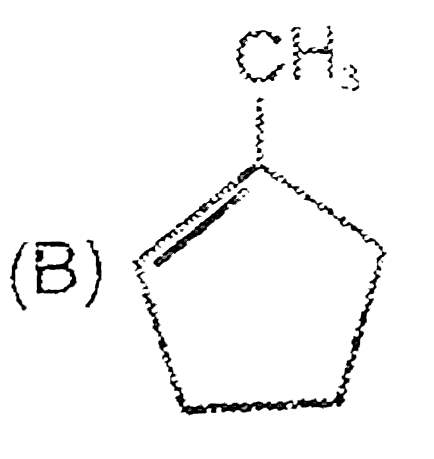A compound (P) having molecular formula C6H10 contains two DU. It yields Q(C6H12) when reacts with excess of H2 of the presence of Ni. On ozonolysis P gives cyclopentanone and compound Y.
IdentifythestructureofthecompoundP




The correct Answer is:D
To identify the structure of compound P with the molecular formula C6H10, we can follow these steps:
Step 1: Determine the Degree of Unsaturation (DU)
The molecular formula C6H10 indicates that the compound has 2 degrees of unsaturation (DU). The formula for calculating the degree of unsaturation is:
DU=(2C+2−H)2
For C6H10:
DU=(2×6+2−10)2=(12+2−10)2=42=2
This confirms that P has 2 degrees of unsaturation.
Step 2: Analyze the Reaction with Hydrogen
The compound P reacts with excess hydrogen (H2) in the presence of nickel (Ni) to yield Q with the formula C6H12. This indicates that P has unsaturation (double bonds or rings) that can be hydrogenated to form a saturated compound Q.
Step 3: Consider Ozonolysis Products
Upon ozonolysis, P yields cyclopentanone and another compound Y. Cyclopentanone has a five-membered ring with a carbonyl group. This suggests that P likely contains a ring structure that, when cleaved, produces cyclopentanone.
Step 4: Structure Elucidation
Given that P has 2 degrees of unsaturation, one possibility is that it contains a cyclopentene structure (a five-membered ring with one double bond) and another double bond elsewhere in the molecule.
Step 5: Identify the Structure
The structure of P can be deduced as follows:
- A cyclopentene ring accounts for one degree of unsaturation.
- An additional double bond (possibly in a chain) accounts for the second degree of unsaturation.
Thus, the structure of P can be represented as:
Cyclopentene with an additional double bond
Conclusion
The structure of compound P is likely to be 1-hexene or a similar compound that contains a cyclopentene ring and one additional double bond.
The molecular formula C6H10 indicates that the compound has 2 degrees of unsaturation (DU). The formula for calculating the degree of unsaturation is:
DU=(2C+2−H)2
For C6H10:
DU=(2×6+2−10)2=(12+2−10)2=42=2
This confirms that P has 2 degrees of unsaturation.
The compound P reacts with excess hydrogen (H2) in the presence of nickel (Ni) to yield Q with the formula C6H12. This indicates that P has unsaturation (double bonds or rings) that can be hydrogenated to form a saturated compound Q.
Upon ozonolysis, P yields cyclopentanone and another compound Y. Cyclopentanone has a five-membered ring with a carbonyl group. This suggests that P likely contains a ring structure that, when cleaved, produces cyclopentanone.
Given that P has 2 degrees of unsaturation, one possibility is that it contains a cyclopentene structure (a five-membered ring with one double bond) and another double bond elsewhere in the molecule.
The structure of P can be deduced as follows:
- A cyclopentene ring accounts for one degree of unsaturation.
- An additional double bond (possibly in a chain) accounts for the second degree of unsaturation.
Cyclopentene with an additional double bond
The structure of compound P is likely to be 1-hexene or a similar compound that contains a cyclopentene ring and one additional double bond.
Topper's Solved these Questions
- BOOK - RESONANCE ENGLISHCHAPTER - STRUCTURAL IDENTIFICATIONEXERCISE - Advanced level Problems (Part-III)12videos
STRUCTURAL IDENTIFICATION
- BOOK - RESONANCE ENGLISHCHAPTER - STRUCTURAL IDENTIFICATIONEXERCISE - Advanced level Problems (Part-I)29videos
STRUCTURAL IDENTIFICATION
- BOOK - RESONANCE ENGLISHCHAPTER - STEREOISOMERISMEXERCISE - EXERCISE (PART III : PRACTICE TEST-2 (IIT-JEE (ADVANCED PATTERN))23videos
STEREOISOMERISM
- BOOK - RESONANCE ENGLISHCHAPTER - SURFACE CHEMISTRYEXERCISE - Section - 51videos
SURFACE CHEMISTRY
Similar Questions
A compound (P) having molecular formula C6H10 contains two DU. It yields Q(C6H12) when reacts with excess of H2 of the presence of Ni. On ozonolysis P gives cyclopentanone and compound Y.
The compound Q gives the number of of monochlorination productsView SolutionWhich of the compounds with molecular formula C5H10yields acetone on ozonolysis ?
View SolutionCompound (X) having molecular formula C6H12Cl2 on hydrolysis gives a ketone. Therefore (X) will be
View SolutionA compound (A) with molecular formula C5H10 gives one monochlorination product. Compound (A) is:
View SolutionA compound with molecular formula C8H14, contains 12 secondary and two tertiary H atoms. The compound is :
View SolutionCompound (A)(C8H12) on oxidation gives an acid B(C4H6O2). One mole of compound (A) reacts with 3mol of H2 in the presence of Pt catalyst to give octane. Identify compound (A).
View SolutionThe structure of the compound with molecular formula C6H12 that has only 2∘ H atoms is:
View SolutionA compound [A] of molecular formula C4H9Br yields a compound [B] of molecular formula C4H10O when reated with aqueous NaOH. On oxidation [B] gives a ketone [C]. The vigorous oxidation of ketone gives ethanoic acid. Deduce the structure of A, B and C.
View SolutionA compound Z with molecular formula C3H9N reacts with C6H5SO2Cl to give a solid, insoluble in alkali. Identify Z.
View SolutionAn organic compound E(C5H8) on hydrogenation gives compoundF(C5H12). Compound E on ozonolysis gives formaldehyde and 2-ketopropanal. Deduce the structure of compound E.
View Solution

